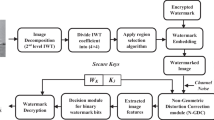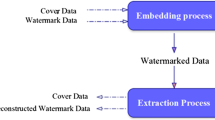Abstract
Code division multiple access (CDMA) at its multicarrier version of image watermarking scheme that is robust against random gain operation as well as enables high embedding rate is developed in this paper. Watermark embedding is done on mutually orthogonal set of host image samples wherein data bits are embedded using an orthogonal set of code patterns. Watermark decoding is also proposed by exploiting the principle of minimum mean square error combining. The decision variable for the binary watermark is the resultant weighted decision statistics. A generalized model of attack that consists of multiplicative and additive degradation on the watermarked image is considered. The first one follows Rayleigh distribution and the second one Gaussian distribution. We mathematically show that the proposed decoder structure incorporates the effect of random gain (fading attack) unlike the widely used correlator decoder. The concept of multiuser detection principle which is widely used in CDMA is then explored to cancel the effect of multiple bit interference in watermarking. Two variants of combined interference cancellation (CIC), namely threshold combined interference cancellation (TCIC) and group combined interference cancellation (GCIC) are then developed. Mathematical analysis and the results through simulations show that TCIC and CIC offer similar decoding error rate performance. On the other hand, a significant improvement in decoding error performance and payload are achieved through GCIC. Finally, the proposed method is studied for image error concealment and performance comparison is reported over the existing methods.















Similar content being viewed by others
References
Cox, I. J., Kilian, J., Leighton, F. T., & Shamoon, T. (1996). Secure spread spectrum watermarking for multimedia. IEEE Transaction on Image Processing, 6(12), 1673–1687.
Maity, S. P., Maity, S., Sil, J., & Delpha, C. (2013). Optimized spread spectrum watermarking for fading-like attack with improvd Detection. Special Issue on Wireless Personal Communications, 72(3), 1737–1753.
Bose, A., & Maity, S. P. (2017). Spread spectrum watermark detection on degraded compressed sensing. IEEE Sensor Letters, 1(5), 1–4.
Maity, S. P., Maity, S., Sil, J., & Delpha, C. (2014). Perceptually adaptive MC-SS image watermarking using GA-NN Hybridization in fading gain. Special Issue on Engineering Applications of Artificial Intelligence, 31, 3–14.
Maity, S. P., Kundu, M. K., & Das, T. S. (2007). Robust SS watermarking with improved capacity. Pattern Recognition Letters, 28, 350–356.
Kundur, D., & Hatzinakos, D. (2001). Diversity and attacks characterization for improved robust watermarking. IEEE Transactions on Signal Processing, 29, 2383–2396.
Maity, S. P., Maity, S., & Sil, J. (2009). Diversity assisted GCIC for spread spectrum watermark detection using genetic algorithms. In Proceedings of IEEE conference on image processing, Cairo, Egypt (pp. 3649–365).
Kumar, S. K., & Sreenivas, T. (2007). Increased watermark-to-host correlation of uniform random phase watermarks in audio signals. Signal Processing, 87, 61–67.
Kim, H. (2000). Stochastic model based audio watermark and whitening filter for improved detection. In Proceedings of IEEE international conference on acoustics, speech and signal processing (pp. 1971–1974).
Seok, J. W., & Hong, J. W. (2001). Audio watermarking for copyright of digital audio data. IEEE Electronic Letters, 37, 60–61.
Cvejic, N., & Seppanen, T. (2002). Audio prewhitening based on polynomial filtering for optimal watermark detection. In Proceedings of European signal processing conference.
Haitsma, J. A., van der Veen, M., Kalker, T., & Bruekers, F. (2000). Audio watermarking for monitoring and copy protection. In Proceedings of the ACM multimedia workshop (pp. 119–122).
Kirovski, D., & Malvar, H. S. (2003). Spread spectrum watermarking of audio signals. IEEE Transactions on Signal Processing, 51(4), 1020–1033.
Moulin, P., & Koetter, R. (2005). Data-hiding codes. Proceedings of IEEE, 93(12), 2083–2126.
Cha, B.-H., & Kuo, C.-C. J. (2009). Robust MC-CDMA-based fingerprinting against time-varying collusion attacks. IEEE Transaction on Information Forensics and Security, 4(3), 302–317.
Kumsawat, P., Attakitmongcol, K., & Srikaew, A. (2005). A new approach for optimization in image watermarking by using genetic algorithms. IEEE Transactions on Image Processing, 53, 4707–4719.
Malver, H., & Florencio, A. F. (2003). Improved spread spectrum: A new modulation technique for robust watermarking. IEEE Transactions on Image Processing, 51, 898–905.
Kutter, M. (1999). Performance improvement of spread spectrum based image watermarking schemes through M-ary modulation. In Proceedings of the workshop on information hiding, LNCS-1768 (pp. 238–250). New York: Springer.
Maity, S. P., Kundu, M. K., & Mandal, M. (2006). Performance improvement in spread spectrum watermarking via M-band wavelets and N-ary modulation. In Proceedings of IET international conference on visual information engineering, Bangalore, India (pp. 35–40).
Maity, S. P., Mait, S., & Sil, J. (2012). Multicarrier spread spctrum watermarking for secure error concealment in fading channel. Telecommunication Systems, 49, 239–254.
Bhattacharjee, T., & Maity, S. P. (2017). An image-in-image communication scheme using secretsharing and M-ary spread spectrum watermarking. Microsystem Technologies, 23(9), 4263–4276.
Maity, S. P., & Maity, S. (2009). Multistage spread spectrum watermark detection technique using fuzzy logic. IEEE Signal Processing Letters, 16(4), 245–248.
Faragallah, O. S. (2016). Transmission of DWT block-based KLT watermarked images through MC-CDMA wireless channel. Wireless Personal Communications, 90(3), 1387–1404.
Prasad, R. (1996). CDMA for wireless personal communications. Boston: Artech House.
Hara, S., & Prasad, R. (1997). Overview of multicarrier CDMA. IEEE Communications Magazine, 35(12), 126–133.
Maity, S. P., & Hati, S. (2015). On optimization of CI/MC-CDMA system through channelestimation. Wireless Personal Communicaion Journal, 85(4), 2333–2354.
Phadikar, A., & Maity, S. P. (2012). Image concealment and quality access control based on data hiding and cryptography. Springer Telecommunication Journal, 49, 236–254.
Chen, B. N., & Lin, Y. (2006). Hybrid error concealment using linear interpolation. In Proceedings of international symposium on communications and information technologies (pp. 926–931).
Ma, M., Au, O. C., Chan, S. H. G., & Sun, M. T. (2009). Edge-directed error concealment. IEEE Transaction on Circuits and Systems for Video Technology, 20, 382–395.
Wu, J., Liu, X., & Yoo, K. Y. (2008). A temporal error concealment method for H.264/AVC using motion vector recovery. IEEE Transactions on Consumer Electronics, 54(4), 1880–1885. https://doi.org/10.1109/TCE.2008.4711249.
Lee, P. J., Chen, H. H., & Chen, L. G. (2004). A new error concealment algorithm for H.264/AVC video transmission. In Proceedings of international symposium on intelligent multimedia, video, and speech processing (pp. 619–622).
Liu, Y., & Li, Y. (2000). Error concealment for digital images using data hiding. In Proceedings of the ninth DSP workshop (pp. 1–6).
Gur, G., Alagoz, F., & AbdelHafez, M. (2005). A novel error concealment method for images using watermarking in error-prone channels. In Proceedings of 16th IEEE international symposium on personal, indoor and mobile radio communications (pp. 2637–2641).
Koloda, J., Ostrergaard, J., Jensen, S. H., Sanchz, V., & Peinado, A. M. (2013). Squential error concealment for video/image by sparse linar prediction. IEEE Transactions on Multimedia, 14(4), 957–969.
Xu, D., Wang, R., & Shi, Y. Q. (2014). An improved reversible data hiding based approach for interframe error concealment in H. 264/AVC. Journal of Visual Communication and Image Representation, 25(2), 410–422.
Anhari, A. K., Sodagari, S., & Avanaki, A. N. (2008). Hybrid error concealment in image communication using data hiding and spatial redundancy. In Proceedings of international conference on telecommunications (pp. 1–5).
Wang, H., Tsaftaris, S. A., & Katsaggelos, A. K. (2006). Joint source-channel coding for wireless object-based video communications utilizing data hiding. IEEE Transactions on Image Processing, 15, 215–2169.
Maity, S. P., & Maity, S. (2015). On dtection improvement in MC-CDMA image watermarking on fading channel. In 18th International symposium on wireless personal multimedia communication, 13–16 Decembr , Hyderabad, India.
Thippavajjula, V., & Natarajan, B. (2004). Parallel interference cancelation techniques for synchronous carrier interferometry/MC-CDMA uplink. In IEEE vehicular technology conference (pp. 399–403).
Wong, P. W. (1993). Inverse halftoning and kernel estimation for error diffusion. Media Technology Laboratory (pp. 1–23).
Author information
Authors and Affiliations
Corresponding author
Appendix A
Appendix A
The minimum mean square error combining method estimates the j-th embedded watermark bit by the linear sum
where \(w_{n}\) is the weight factor for MMSEC. The working principle of MMSEC dictates that the estimation error for watermark bit decoding must be orthogonal to all the components of the received marked data. Mathematically can be written as
when \(n=1,2 \ldots N\).
The weight factor \(w_{n}^{j}\) can be found from the solution to (16) by applying Wiener filter theory [40] and may be written as
where \(C=E\bigl \lbrace r_{n}^{j}r_{n}^{j}\mid \alpha _{n}\bigr \rbrace \) and \(A=E\bigl \lbrace b_{n}^{j}r_{n}^{j}\mid \alpha _{n}\bigr \rbrace \). The symbol \(E\bigl \lbrace .\bigr \rbrace \) denotes the expected value. This operation, when applied to the \(r_{n}^{j}\) yields
and
The weight factors for MMSEC watermark decoding can be found by substituting (18) and (19) in (17)
and from (15)
Rights and permissions
About this article
Cite this article
Maity, S.P., Maity, S. On Detection Improvement in MC-CDMA Image Watermarking on Fading Channel. Wireless Pers Commun 100, 587–609 (2018). https://doi.org/10.1007/s11277-017-5222-z
Published:
Issue Date:
DOI: https://doi.org/10.1007/s11277-017-5222-z




